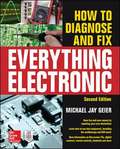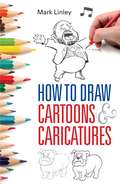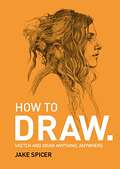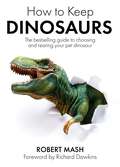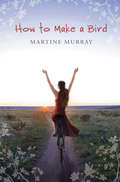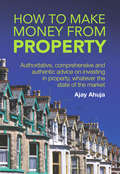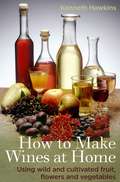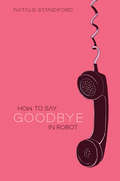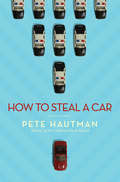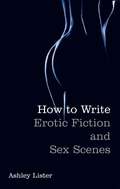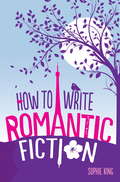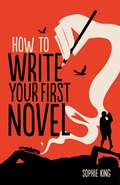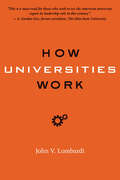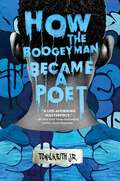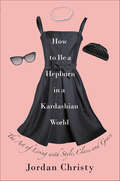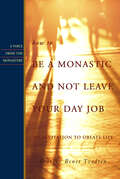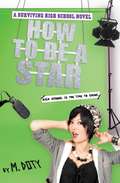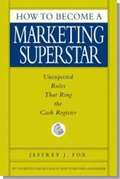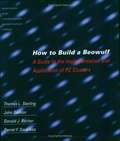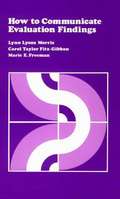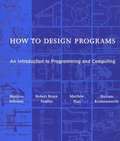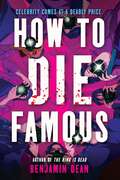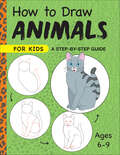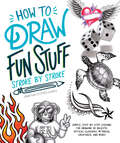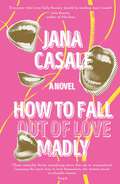- Table View
- List View
How To Diagnose And Fix Everything Electronic
by Michael Jay GeierRepair all kinds of electrical products, from modern digital gadgets to analog antiques, with help from this updated book. How to Diagnose and Fix Everything Electronic, Second Edition, offers expert insights, case studies, and step-by-step instruction from a lifelong electronics guru. Discover how to assemble your workbench, use the latest test equipment, zero in on and replace dead components, and handle reassembly. Instructions for specific devices, including stereos, MP3 players, digital cameras, flat-panel TVs, laptops, headsets, and mobile devices are also included in this do-it-yourself guide. Choose the proper tools and set up your workbench Ensure personal safety and use proper eye and ear protection Understand how electrical components work and why they fail Perform preliminary diagnoses based on symptoms Use test equipment, including digital multimeters, ESR meters, frequency counters, and oscilloscopes Interpret block, schematic, and pictorial diagrams Disassemble products and identify sections Analyze circuits, locate faults, and replace dead parts Re-establish connections and reassemble devices
How To Draw Cartoons and Caricatures
by Mark LinleyLearn to draw the fun way! Like almost everyone in the world, you are bursting with raw artistic talent just waiting to be released. In a few deft sweeps of your pencil, capture the character of your 'victim'. Use swift strokes to create a face that has instant appeal. Exaggerate the features to make a comical caricature. Brighten up someone's day with your own tiny bit of magic!"Yes, you can do it," says Mark Linley, "and I show you exactly how!"
How To Draw: Sketch and draw anything, anywhere with this inspiring and practical handbook
by Jake SpicerJake Spicer wants you to learn how to draw. This is his complete course in drawing, suitable for complete beginners as well as experienced artists, and designed to help you fit drawing into your lifestyle. Tried-and-tested exercises, ranging from five-minute sketches to dedicated sessions of an hour or longer, cover every subject and location you could wish for, while accessibly written drawing theory helps you relate the technical concepts to your practice, helping you to hone your craft. Whatever your goals are, expert art tutor Jake Spicer gives you the inspiration and encouragement to draw more - and keep improving.
How To Keep Dinosaurs: The perfect mix of humour and science
by Robert Mash'Who could resist a handbook about potential pets that has a little symbol for "likes children" and a separate one for "likes children to eat"... wonderful' GUARDIANHollywood and the popular press would have us believe that all dinosaurs are gigantic, hostile and untameable. In fact, there are many species that make charming and even useful companions: Velociraptor - a splendid, loyal, fierce, friendDeinonychus - will not eat dog food (dogs are another matter)Tyrannosaurus - least suitable to keep; will need special licenceOrnithomimus - an appealing first dinosaur for the child anxious for her first rideThis book advises you which dinosaur is right for you and your home, from the city apartment dweller looking for a lap pet, to the country estate owner looking to tighten up on security. HOW TO KEEP DINOSAURS is a bestselling guide, packed with the sort of information keen dinosaur keepers crave - from feeding and housing to curing common ailments, breeding and showing your animal. The author, a zoologist with extensive experience of dinosaurs, has provided a timely and much-needed source book for all those who keep dinosaurs and for the huge numbers who are contemplating getting one. It is as essential to every dinosaur keeper as a stout shovel and a tranquilliser rifle.
How To Make A Bird
by Martine MurrayA beautiful novel that captures the aching of a teenager ready to heal.It's dawn, on an empty road in the countryside. Empty, except for the girl in the long, red evening gown, standing next to a bicycle, and looking back at the home she's about to leave. Mannie's ready to start a new life and forget the terrible things that have happened here, but there are questions that need to be answered before she can let go. Questions about her elegant but unstable mother, her brother who's always overshadowed her, and his friend Harry Jacob, who just might be Mannie's boyfriend . . .
How To Make Money From Property: Authoritative, Comprehensive, And Authentic Advice On Investing In Property, Whatever The State Of The Market
by Ajay AhujaThere are a surprising number of ways that you can make money from property. This book will not only explain those ways but will help you decide which method is right for you based on your personal profile and attitude to risk. It will also help you to modify and fine tune your attitudes and approaches so that you can choose whether to enter the more lucrative avenues of property investment which the professionals exploit. Learn how to: - Turn your own home (whether owned or not) into a tax free, money making machine - Build a massive property portfolio just like the professionals and generate an income big enough to live on and more - Make money by refurbishing properties and getting top dollar for them - Get hotel room rates for your well located apartment in a city centre - Buy properties for GBP1 by using the appropriate legal documents - such as options (full documentation is within this book) - Make GBP000s in weeks without doing anything but shuffle a few bits of legal paperwork by flippingA" properties - Profit from the lucrative bed and breakfast market without the need for any experience - Profit from the ever growing student property lettings market and stay within current legislation - Build a profitable UK based holiday letting business
How To Make Wines at Home: Using wild and cultivated fruit, flowers and vegetables
by Kenneth HawkinsThis book covers the basics of making wine and how and what various types differ. The author shows you how to train your palate so that you are able judge the relative qualities of the wine you produce. It includes 55 recipes as well as instructions for racking, processing and maturing.
How To Say Goodbye In Robot
by Natalie StandifordFrom bestselling author Natalie Standiford, an amazing, touching story of two friends navigating the dark waters of their senior year.New to town, Beatrice is expecting her new best friend to be one of the girls she meets on the first day. But instead, the alphabet conspires to seat her next to Jonah, aka Ghost Boy, a quiet loner who hasn't made a new friend since third grade. Something about him, though, gets to Bea, and soon they form an unexpected friendship. It's not romance, exactly - but it's definitely love. Still, Bea can't quite dispel Jonah's gloom and doom - and as she finds out his family history, she understands why. Can Bea help Jonah? Or is he destined to vanish?
How To Steal a Car
by Pete HautmanFrom National Book Award winner Pete Hautman, the story of a girl who acts out by stealing cars.Some girls act out by drinking or doing drugs. Some girls act out by sleeping with guys. Some girls act out by starving themselves or cutting themselves. Some girls act out by being a bitch to other girls. Not Kelleigh. Kelleigh steals cars.In How to Steal a Car, National Book Award winner Pete Hautman takes teen readers on a thrilling, scary ride through one suburban girl's turbulent life - one car theft at a time.
How To Write Erotic Fiction and Sex Scenes
by Ashley ListerWhether you're writing a steamy erotic novel, or a romantic novel and want to take the reader beyond the bedroom door, writing a convincing sex scene can be one of the most difficult challenges for any fiction writer. How to Write Erotic Fiction and Sex Scenes is a practical guide to help every writer rise to this challenge.
How To Write Romantic Fiction
by Sophie KingRomantic fiction is one of the most competitive areas for a writer to crack. Whether you?re a beginner or an already-published writer, you?ll find something new here.This book will help you to write novels that both sizzle and sell. You'll learn how to dream up heroes and heroines who breathe (heavily) from the page, plan plots to keep the reader up all night, find a happy ending, which is both surprising and believable - and most importantly get published!
How To Write Your First Novel
by Sophie KingThis revised edition takes aspiring novelists through the steps of writing a novel, from finding that initial idea, to keeping the plot going and crafting the perfect ending. With helpful exercises in each chapter you will learn how to:- Develop a brilliant idea for your first novel - Create characters that will make your novel come alive - Plot your novel so that your readers simply have to turn the page - Unravel the mysteries of viewpoint - Create realistic dialogue and settings so your readers feel they are there - Find your own voice. - Most importantly, the book includes tips and advice on how to get published. This new edition also includes a ten step guide to revision so that you can polish your novel to be the best it can be.
How Universities Work (Higher Ed Leadership Essentials)
by John V. LombardiThe single best description of the inside workings of contemporary universities.Witty and insightful, How Universities Work is destined to be an essential handbook for anyone wanting to understand universities in the United States. John V. Lombardi gives readers an insider’s view of the academy, describing the structure, logic, dynamics, and operational styles of both public and private institutions of higher education. Lombardi defines and describes all the bits and pieces that compose a university with remarkable economy—from budgeting systems to tenure, from the library to the athletic field. Although focused on research universities, much of the discussion applies to other types of post-secondary institutions. Ideal for students, this book will form a solid foundation for courses in higher education, but it will also be a welcome addition to faculty and administrators’ personal libraries.
How the Boogeyman Became a Poet
by Tony Keith, Jr.Poet, writer, and hip-hop educator Tony Keith Jr. makes his debut with a powerful YA memoir in verse, tracing his journey from being a closeted gay Black teen battling poverty, racism, and homophobia to becoming an openly gay first-generation college student who finds freedom in poetry. Perfect for fans of Elizabeth Acevedo, George M. Johnson, and Jacqueline Woodson.Tony dreams about life after high school, where his poetic voice can find freedom on the stage and page. But the Boogeyman has been following Tony since he was six years old. First, the Boogeyman was after his Blackness, but Tony has learned It knows more than that: Tony wants to be the first in his family to attend college, but there’s no path to follow. He also has feelings for boys, desires that don’t align with the script he thinks is set for him and his girlfriend, Blu.Despite a supportive network of family and friends, Tony doesn’t breathe a word to anyone about his feelings. As he grapples with his sexuality and moves from high school to college, he struggles with loneliness while finding solace in gay chat rooms and writing poetry. But how do you find your poetic voice when you are hiding the most important parts of yourself? And how do you escape the Boogeyman when it's lurking inside you?
How to Be a Hepburn in a Kardashian World: The Art of Living with Style, Class, and Grace
by Jordan ChristyJordan Christy shares advice on how to be the most confident version of yourself, in this fully revised and updated edition derived from How to Be a Hepburn in a Hilton World.Though fashions may change, certain things never go out of style -- like your favorite little black dress that can take you from a business meeting to a dinner party to a night on the town. But what makes it work is not the dress, it's how you present yourself while wearing it. A woman who is polite, well spoken, gracious, charming, and thoughtful is always welcome-though such women appear to be in short supply these days! Despite the headline-grabbing antics of certain flashy celebutantes, most of us would rather have respect -- for ourselves and from our family, friends, and colleagues.In this fully revised and updated edition, you will learn how to: Appear polished without sacrificing your personal style, Develop skills and discover interests to boost your self-confidence,Find your true friendships and make them stronger,Date Mr. Right instead of hooking up with Mr. Right Now,Land the perfect internship and your first job,Have a fun night without the risk of a social media faux pas.With this insightful guide you'll be loving life with style, class, and grace in no time!
How to Be a Monastic and Not Leave Your Day Job: A Guide for Benedictine Oblates and Other Christians Who Follow the Monastic Way (Voices from the Monastery)
by Benet TvedtenDiscussion around the bestseller The Benedict Option by Rod Dreher has led many people to want to know more about Benedictine principles. Originally written for monks, the principles in the Rule of St. Benedict may be applied by anyone — and in today's hectic, changing world, following its principles offers a rich spiritual connection to the stability and wisdom of monastic life. This essential guide explains how people who live and work in "the world" are still invited to balance work with prayer, cultivate interdependence with others, practice hospitality, and otherwise practice their spirituality like monks.
How to Be a Star (Surviving High School #2)
by M. DotyHigh school is the time to shine.Tired of playing sidekick to her superstar-athlete best friend, Kimi Chen has decided it's time to step into the spotlight and snag her own place at the coveted center table of the cafeteria. When her low-budget music video hits the Web and goes viral, forget about being just popular -- Kimi is famous! Boys want to date her, girls want to be her, and she is even asked to perform on her favorite TV show. After years of feeling stranded on the bottom rung of the social ladder, Kimi finds that things are finally looking up.But when fame gets in the way of her friendships, Kimi's celebrity begins to lose some of its sparkle. Being a star, it turns out, may be more than she bargained for.Discover the high price of fame and stardom in this second novel in the Surviving High School series, based on the hit mobile game from Electronic Arts.
How to Become a Marketing Superstar: Unexpected Rules that Ring the Cash Register
by Jeffrey J. FoxWith more than 600,000 books in print, nationally bestselling author Jeffrey Fox is back to 'outfox the competition'--this time with counterintuitive advice on how to become a marketing genius n his four previous bestselling business books, Jeffrey Fox has helped readers land great jobs and rise to the top of their professions. Now he turns his contrarian eye to marketing through brand building and innovation. Fox's advice is delivered in snappy, to-the-point chapters that zero in on his creative--and often counterintuitive--advice and features such unforgettable fundamentals as: Make a big splash, instead of a lot of little ripples Always have a pipeline to the president Own a market, not a mill The long and short definitions of marketingThere are also provocative 'Instant Marketing Superstar' challenges throughout the book, offering the reader a chance to solve real business problems. In a time of corporate budget cuts, it's more important than ever for all employees to be creative marketers. How to Become a Marketing Superstar is certain to find a place on the shelves of anyone who wants to increase sales in a competitive marketplace.
How to Build a Beowulf: A Guide to the Implementation and Application of PC Clusters
by Thomas L. Sterling John Salmon Donald J. Becker Daniel F. SavareseSupercomputing research--the goal of which is to make computers that are ever faster and more powerful--has been at the cutting edge of computer technology since the early 1960s. Until recently, research cost in the millions of dollars, and many of the companies that originally made supercomputers are now out of business. The early supercomputers used distributed computing and parallel processing to link processors together in a single machine, often called a mainframe. Exploiting the same technology, researchers are now using off-the-shelf PCs to produce computers with supercomputer performance. It is now possible to make a supercomputer for less than $40,000. Given this new affordability, a number of universities and research laboratories are experimenting with installing such Beowulf-type systems in their facilities. This how-to guide provides step-by-step instructions for building a Beowulf-type computer, including the physical elements that make up a clustered PC computing system, the software required (most of which is freely available), and insights on how to organize the code to exploit parallelism. The book also includes a list of potential pitfalls.
How to Communicate Evaluation Findings
by Lynn Lyons Morris Carol Taylor Fitz-Gibbon Marie E. FreemanThe purpose of this book is to help you communicate the evaluation information you have collected. The book contains prescriptions and advice to help an evaluator provide information that will be usable and used at many stages of a program's development.
How to Design Programs: An Introduction to Programming and Computing
by Matthias Felleisen Robert Bruce Findler Shriram Krishnamurthi Matthew FlattThis introduction to programming places computer science in the core of a liberal arts education. Unlike other introductory books, it focuses on the program design process. This approach fosters a variety of skills--critical reading, analytical thinking, creative synthesis, and attention to detail--that are important for everyone, not just future computer programmers. The book exposes readers to two fundamentally new ideas. First, it presents program design guidelines that show the reader how to analyze a problem statement; how to formulate concise goals; how to make up examples; how to develop an outline of the solution, based on the analysis; how to finish the program; and how to test. Each step produces a well-defined intermediate product. Second, the book comes with a novel programming environment, the first one explicitly designed for beginners. The environment grows with the readers as they master the material in the book until it supports a full-fledged language for the whole spectrum of programming tasks. All the book's support materials are available for free on the Web. The Web site includes the environment, teacher guides, exercises for all levels, solutions, and additional projects.
How to Die Famous
by Benjamin DeanFor fans of Little White Lies and Two Can Keep a Secret comes an addictive thriller about a budding teen celebrity secretly investigating his brother's suspicious death while navigating the highs and lows of fame. Rising star Abel Miller has just landed a role in one of the hottest reboots on the Omni Channel, Sunset High. It looks like he&’ll be yet another budding celebrity plucked from obscurity, but he has a secret: his brother, Adam, a mere production associate, died during the filming of the last attempt at Sunset High, and no one knows how... or why. Abel is going to find out. But when he meets the other stars of the show— Lucky, Ryan, and Ella, along with creator Lake Carter— he realizes there&’s even more darkness beneath the shimmer of fame. They all have their own secrets to hide, and one of them is willing to kill to keep it that way.
How to Draw Animals for Kids: A Step by Step Guide (Drawing for Kids Ages 6 to 9)
by Rockridge PressLearn to draw animals with step-by-step activities for kids ages 6 to 9Anyone can be an artist—all you need is your imagination! Learn how to draw beginner-friendly adorable animals with this step-by-step drawing book for kids. It's full of activities, helpful tips, and lots of animals to draw—from cats and dogs to owls and elephants. A great resource for parents and teachers to teach kids to draw shapes, lines, and other drawing basics. Build on these skills, advance to more challenging animals, and then customize them into something unique. Just grab a pencil and get ready to explore the animal kingdom!A world of animals—Draw animals from the land, sea, and sky, including dolphins, bald eagles, sloths, pandas, goldfish, penguins, and more.Step-by-step method—Follow along and develop your drawing from basic shapes like circles and lines all the way to a beautifully detailed animal.Time to get creative—Get your imagination going with blank scenes that let you draw in your own animals, along with extra drawing ideas so you can keep creating.Discover how to draw animals the easy way with the step-by-step instructions in this book about drawing for kids.
How to Draw Fun Stuff Stroke-by-Stroke: Simple, Step-by-Step Lessons for Drawing 3D Objects, Optical Illusions, Mythical
by Jonathan Stephen HarrisA fresh and exciting drawing guide for young artists who seek projects that are out of the ordinary.Are you tired of drawing the same boring stuff? Artist and author Jonathan Stephen Harris shows you how to draw almost anything with 40 fun and exciting projects that are anything but boring. You'll learn how to create crazy trick art, amazing 3D objects, mind-blowing anamorphic illustrations, and brain-twisting optical illusions. Every project features detailed, step-by-step instructions and illustrations that use color to help teach you exactly how to do it. You'll start by learning the basics of drawing, what tools you need, and the basic techniques you need to know so you can create your own amazing drawings. Soon you'll be creating works of amazing art that is out of this world! Here's what's inside:40 exciting drawing projects that will thrill young artists of all levels of ability.Detailed, step-by-step instructions that take readers through every drawing from start to finish, using color to illustrate new lines so the reader can clearly see the next steps.Simple tutorials for basic drawing skills like shading as well as creating textures and surfaces so readers can learn drawing the right way.Tons of creative ideas that will inspire you to create your own amazing works of art.
How to Fall Out of Love Madly
by Jana Casale&“Three relatable thirty somethings drive this ode to womanhood. Learning the hard way to love themselves, the women teach invaluable lessons.&”—People &“Everyone who loves Sally Rooney should be reading Jana Casale!&”—Julie Buntin, author of Marlena Three women confront the compromises they&’ve made to appease the men they love. Joy and Annie are friends and roommates whose thirty-something lives aren&’t exactly what they&’d imagined. To make ends meet, they decide to rent their extra bedroom to Theo, who charms Joy with his salt-and-pepper hair and adoration of their one-eyed cat. When Annie goes to live with her boyfriend, Theo and Joy settle into a comfortable domesticity. Then Theo brings home Celine, the girlfriend he&’s never mentioned, who is possibly the most stunning woman Joy has ever seen. Joy resolves to do whatever it takes to hold on to him, falling ever deeper into an emotional hellscape of her own making. She is too obsessed to realize that Celine&’s beauty doesn&’t protect her from pain. Haunted by an event from her past, Celine can&’t escape her shame and finds herself in an endless cycle of self-sabotage. Annie is baffled by Joy&’s senseless devotion to Theo, but she&’s consumed by her own obsessions: she can&’t stop parsing her commitment-phobic boyfriend&’s texts in an exhausting mission to maintain his approval. At work, where she fully embraces her natural assertiveness, Annie is a star. But when an anonymous letter lands on her desk accusing her esteemed and supportive boss of sexual misconduct, she is forced to decide who and what she&’s willing to stand up for. Perceptive, mordantly funny, and full of heart, How to Fall Out of Love Madly examines women&’s many relationships—with one another, their mothers, their work, men, and themselves—to reveal their underlying power and complexity. It asks, why do so many smart, compassionate, otherwise empowered women tolerate egregious behavior from the men they love? And what will it take for them to reclaim control?
